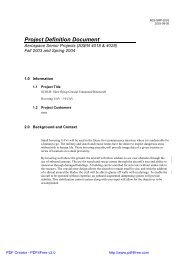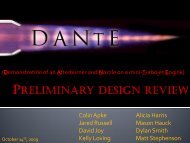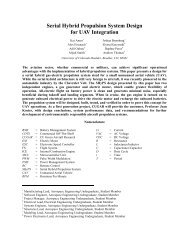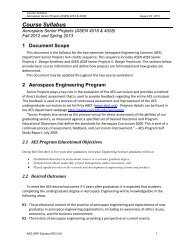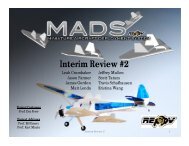PFR - Aerospace Engineering Sciences Senior Design Projects ...
PFR - Aerospace Engineering Sciences Senior Design Projects ...
PFR - Aerospace Engineering Sciences Senior Design Projects ...
You also want an ePaper? Increase the reach of your titles
YUMPU automatically turns print PDFs into web optimized ePapers that Google loves.
Project Final Report – CUDBF April 30 th , 2009<br />
ASEN 4028: <strong>Aerospace</strong> <strong>Senior</strong> <strong>Projects</strong><br />
means that the aircraft will be more directionally stable. With the main geometry of the wing<br />
selected, the only parameter to determine is the sizing of the vertical tail. A tail volume<br />
coefficient of 0.04 was used giving the two vertical tails an area of 0.69 ft 2 . The vertical tails are<br />
shaped with a taper ratio of 0.5 and a straight trailing edge. This drove the vertical tails to be<br />
13.25 inches tall. Table 6 summarizes the geometry of the aircraft.<br />
Table 6: Characteristics of Aircraft Geometry<br />
Parameter<br />
Value<br />
Leading Edge Sweep, Λ LE 23 degrees<br />
Quarter Chord Sweep, Λ c/4 19 degrees<br />
Trailing Edge Sweep, Λ TE 7.3 degrees<br />
Span, b 68”<br />
Wing Area, S 7.14 ft 2<br />
Aspect Ratio, AR 4.5<br />
Root Chord, c root 20.16”<br />
Tip Chord, c tip 10.08”<br />
Taper Ratio, λ 0.5<br />
Winglet Height 13.25”<br />
Winglet Taper Ratio, λ v 0.5<br />
Wing Area, S v 0.69 ft 2<br />
8.1.2 Airfoil Selection and Aerodynamic Twist<br />
The airfoil chosen for the root of the aircraft was the HS602. This airfoil was chosen for the root<br />
primarily because it has a thickness to chord ratio of 10.21%. Because this aircraft does not have<br />
a fuselage, the wings will house the batteries, motor mounts, release mechanism mounts, the<br />
servos and the wiring. In order to ensure that these components will be housed in the wing, the<br />
root must have a reasonably thick airfoil.<br />
From a stability standpoint, it is ideal to have an airfoil with a moment coefficient of 0. Of all the<br />
airfoils analyzed, the airfoil that had the smallest moment coefficient was the HS520 airfoil<br />
(Figure 34). Since the HS520 has a thickness to chord percentage of only 8%, it is not the<br />
optimal choice for the root. In order to make a fair trade between the most desirable thickness to<br />
chord percentage that would house most of the components and the airfoil with the best moment<br />
coefficient, an aerodynamic twist was implemented into the design. The root section has the<br />
HS602 airfoil and the tip has the HS520 airfoil with a linear twist between the root and the tip of<br />
the wing. The winglets have the NACA 0010 airfoil; a symmetric airfoil with a 10% thickness to<br />
chord ratio.<br />
61




